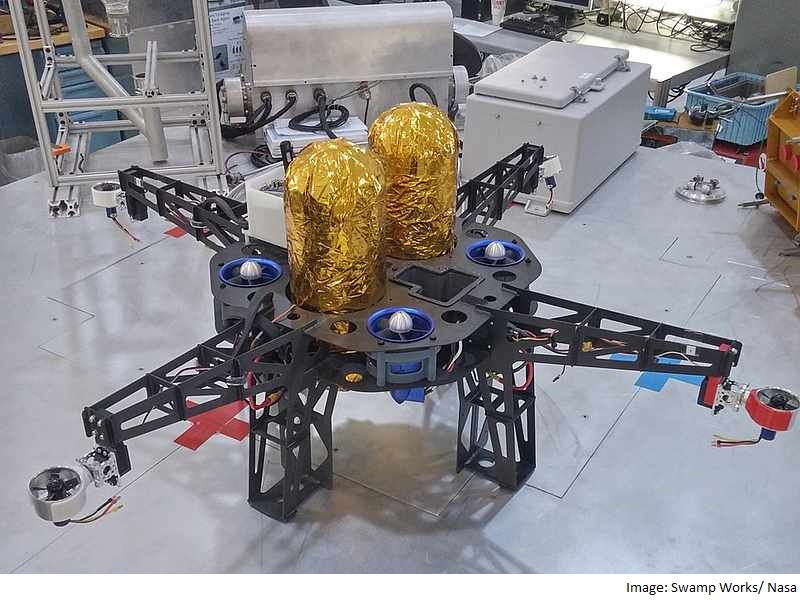- Home
- Science
- Science News
- Nasa Drones to Explore Moon and Mars
Nasa Drones to Explore Moon and Mars

The flying robotic vehicles - similar to quad-copters but designed for the thin atmosphere of Mars and the airless voids of asteroids and the Moon - would use a lander as a base to replenish batteries and propellants between flights.
"This is a prospecting robot," said Rob Mueller, senior technologist for advanced projects at Swamp Works at Nasa's Kennedy Space Center in Florida. "The first step in being able to use resources on Mars or an asteroid is to find out where the resources are. They are most likely in hard-to-access areas where there is permanent shadow.
"Some of the crater walls are angled 30 degrees or more, and that's far too steep for a traditional rover to navigate and climb," he said.
The machines being built fall under the name Extreme Access Flyers, and their designers intend to create vehicles that can travel into the shaded regions of a crater and pull out small amounts of soil to see whether it holds the water-ice promised by readings from orbiting spacecraft.
Running on propellants made from resources on the distant worlds, the machines would be small enough for a lander to bring several of them to the surface at once, so if one fails, the mission is not lost.
Cold-gas jets using oxygen or steam water vapour will take on the lifting and manoeuvring duties performed by the rotors on Earth.
For navigation, the team is programming the flyer to recognise terrain and landmarks and guide itself to areas controllers on Earth send it to or even scout on its own the best places to take samples from. "It would have enough propellant to fly for a number of minutes on Mars or on the Moon, hours on an asteroid," said Mike DuPuis, co-investigator of the Extreme Access Flyer project.
For the sampling itself, designers currently envision a modular approach that would let the flyer take one tool at a time to a sample area to gather about seven grammes of material at a time. That's enough for instruments to analyse and, throughout the course of many flights, is enough to gather samples that would show Earth-bound scientists a complete geological picture of an area.
In the Swamp Works laboratory, the team has assembled several models designed to test aspects of the final machine. A large quad-copter about five feet across that uses ducted fans is about the size of the prototype the team has in mind for an operational mission in space. The uses for the sampling vehicle may not be solely extraterrestrial, Mueller said. On Earth, an aerial vehicle that can pull a few grams of dirt from an area potentially brimming with toxins would be very valuable for first responders or those researching a new area who do not want to risk humans.
For the latest tech news and reviews, follow Gadgets 360 on X, Facebook, WhatsApp, Threads and Google News. For the latest videos on gadgets and tech, subscribe to our YouTube channel. If you want to know everything about top influencers, follow our in-house Who'sThat360 on Instagram and YouTube.
Related Stories
- Galaxy S24 Series
- MWC 2024
- Apple Vision Pro
- Oneplus 12
- iPhone 14
- Apple iPhone 15
- OnePlus Nord CE 3 Lite 5G
- iPhone 13
- Xiaomi 14 Pro
- Oppo Find N3
- Tecno Spark Go (2023)
- Realme V30
- Best Phones Under 25000
- Samsung Galaxy S24 Series
- Cryptocurrency
- iQoo 12
- Samsung Galaxy S24 Ultra
- Giottus
- Samsung Galaxy Z Flip 5
- Apple 'Scary Fast'
- Housefull 5
- GoPro Hero 12 Black Review
- Invincible Season 2
- JioGlass
- HD Ready TV
- Laptop Under 50000
- Smartwatch Under 10000
- Latest Mobile Phones
- Compare Phones
- Itel Super Guru 4G
- Huawei Pura 70 Pro+
- Huawei Pura 70 Ultra
- Tecno Camon 30 Premier 5G
- Motorola Edge 50 Fusion
- Oppo A1i
- Oppo A1s
- Motorola Edge 50 Ultra
- Asus ZenBook Duo 2024 (UX8406)
- Dell Inspiron 14 Plus
- Realme Pad 2 Wi-Fi
- Redmi Pad Pro
- Cult Shock X
- Fire-Boltt Oracle
- Samsung Samsung Neo QLED 8K Smart TV QN800D
- Samsung Neo QLED 4K Smart TV (QN90D)
- Sony PlayStation 5 Slim Digital Edition
- Sony PlayStation 5 Slim
- Onida 1.5 Ton 3 Star Inverter Split AC (IR183PRS)
- IFB 2 Ton 3 Star Inverter Split AC (CI2432C323G1)

















